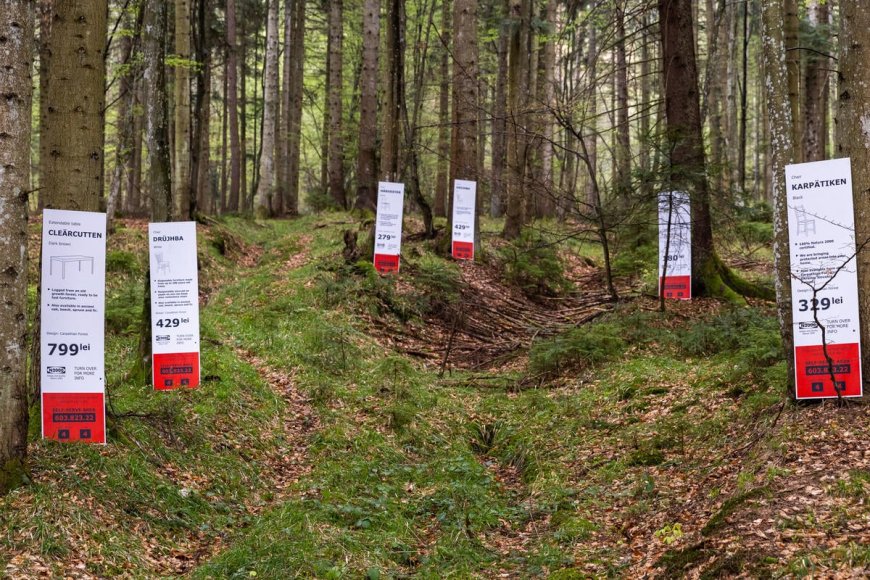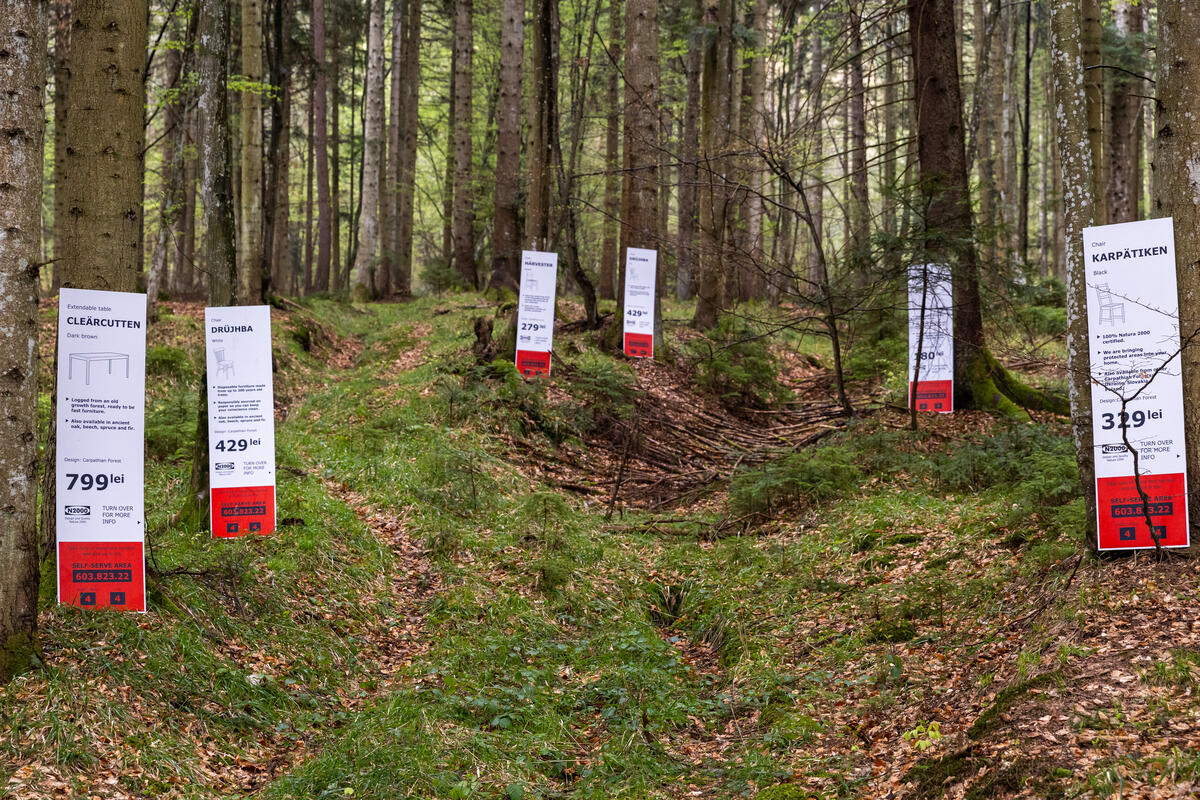IKEA furniture destroys some of Europe’s last remaining ancient forests – Greenpeace International
IKEA furniture destroys some of Europe’s last remaining ancient forests Greenpeace International

Furniture Manufacturers Linked to Destruction of Old-Growth Forests, Including Natura 2000 Protected Areas, for IKEA Products

Bucharest, Romania – A new report by Greenpeace reveals that furniture manufacturers producing for IKEA are sourcing wood from some of Europe’s last remaining old-growth forests in the Romanian Carpathians, including in Natura 2000 protected areas. The investigation found that seven manufacturers, responsible for producing popular IKEA products such as INGOLF chairs and SNIGLAR baby cribs and beds, are linked to the destruction of high-conservation value forests. These products were found in IKEA stores across 13 countries, including Austria, Belgium, Czechia, Finland, France, Germany, Hungary, Italy, Israel, Poland, Sweden, Switzerland, and the UK. Greenpeace is calling on IKEA to take responsibility and address the environmental impact of its supply chain.
Sustainable Development Goals (SDGs)
- Goal 15: Life on Land
- Goal 12: Responsible Consumption and Production
- Goal 13: Climate Action
Robert Cyglicki, Biodiversity Campaign Director at Greenpeace Central and Eastern Europe, stated that the destruction of old forests for furniture production is unacceptable. He urged IKEA to uphold its sustainability promises and take action to protect these vital ecosystems.
The report titled “Assemble the truth: Old-growth forest destruction in the Romanian Carpathians” was conducted by Greenpeace Central and Eastern Europe. The investigation traced the supply chain from logging sites in Romanian forests to wood depots and furniture manufacturers, ultimately leading to IKEA stores. Several manufacturers were found to be sourcing wood from high conservation value forests. Based on publicly available information, it is evident that IKEA is the largest customer of these manufacturers, indicating that the problematic wood is likely used in IKEA furniture. One manufacturer, Plimob, exclusively produces for IKEA, making it certain that the company’s products contain wood from these destructive practices.
Greenpeace CEE provided IKEA with an opportunity to respond to the investigation’s findings. However, IKEA did not dispute the information. While one manufacturer acknowledged receiving timber from a Natura 2000 area and claimed that it is not illegal, several others did not respond.
Greenpeace acknowledges the value of using wood in furniture production for its carbon storage and material utilization benefits. However, this should not come at the expense of the planet’s most biologically diverse forests. The Carpathians are home to various species, including brown bears, lynx, wolves, and European bison. These forests serve as crucial refuges for flora and fauna in Europe. Currently, only 2.4% (1700 km²) of the Romanian Carpathian forests are protected against logging, despite official data indicating that around 7% of Romanian forests are over 120 years old. According to the EU’s Biodiversity strategy, these forests should be strictly protected. Greenpeace urges IKEA to take a leading role in implementing legally binding measures to protect biodiversity and meet Europe’s biodiversity targets.
Photos and Videos
Photos and videos related to this issue can be accessed from the Greenpeace Media Library.
Notes
- Nature Crime File – Declassified: Assemble the truth: Old-growth forest destruction in the Romanian Carpathians, Greenpeace Central and Eastern Europe/ Romania, 2024.
- Manufacturers linked to the destruction of old-growth forests: Masifpanel SRL, Aramis Invest SRL, Taparo SA, CH Industrial Prod SRL, Iris Service Ciuc SA, Plimob SA, Aviva SRL
- Ikea: radiographie d’une contre-offensive médiatique – Le Temps
- Mapping and assessment of primary and old-growth forests in Europe
Contact Information
- Christine Gebeneter, Senior communication strategist at Greenpeace CEE, +43 664 8403807, [email protected]
- Greenpeace International Press Desk, +31 (0)20 718 2470 (available 24 hours), [email protected]
Follow @greenpeacepress on Twitter for our latest international press releases.
SDGs, Targets, and Indicators
1. SDGs Addressed or Connected to the Issues Highlighted in the Article
- SDG 15: Life on Land
- SDG 12: Responsible Consumption and Production
The article highlights the destruction of old-growth forests in the Romanian Carpathians, which is directly related to SDG 15: Life on Land. This goal aims to protect, restore, and promote sustainable use of terrestrial ecosystems, sustainably manage forests, combat desertification, halt and reverse land degradation, and halt biodiversity loss.
The article also indirectly relates to SDG 12: Responsible Consumption and Production. This goal promotes sustainable consumption and production patterns, including the sustainable management and efficient use of natural resources.
2. Specific Targets Under the Identified SDGs
- SDG 15.2: By 2020, promote the implementation of sustainable management of all types of forests, halt deforestation, restore degraded forests, and substantially increase afforestation and reforestation globally.
- SDG 12.2: By 2030, achieve the sustainable management and efficient use of natural resources.
The article highlights the destruction of old-growth forests, which goes against the target of promoting sustainable forest management and halting deforestation (SDG 15.2). It also emphasizes the need for responsible consumption and production practices to ensure the sustainable management and efficient use of natural resources (SDG 12.2).
3. Indicators Mentioned or Implied in the Article
- Extent of forest area protected or conserved
- Extent of forest degradation
- Extent of deforestation
- Proportion of forest area covered by a management plan
- Proportion of products produced sustainably
The article mentions that only 2.4% of the Romanian Carpathian forests are currently protected against logging, indicating the extent of forest area protected or conserved. It also highlights the destruction of old-growth forests, implying the extent of forest degradation and deforestation. Additionally, the article suggests that responsible furniture manufacturers should have management plans in place for sustainable sourcing of wood, indicating the proportion of forest area covered by a management plan. Finally, the article calls for IKEA to clean up its supply chain from old-growth forest destruction, implying the need for sustainable production practices and the proportion of products produced sustainably.
Table: SDGs, Targets, and Indicators
| SDGs | Targets | Indicators |
|---|---|---|
| SDG 15: Life on Land | 15.2: By 2020, promote the implementation of sustainable management of all types of forests, halt deforestation, restore degraded forests, and substantially increase afforestation and reforestation globally. | – Extent of forest area protected or conserved – Extent of forest degradation – Extent of deforestation – Proportion of forest area covered by a management plan |
| SDG 12: Responsible Consumption and Production | 12.2: By 2030, achieve the sustainable management and efficient use of natural resources. | – Proportion of products produced sustainably |
Behold! This splendid article springs forth from the wellspring of knowledge, shaped by a wondrous proprietary AI technology that delved into a vast ocean of data, illuminating the path towards the Sustainable Development Goals. Remember that all rights are reserved by SDG Investors LLC, empowering us to champion progress together.
Source: greenpeace.org

Join us, as fellow seekers of change, on a transformative journey at https://sdgtalks.ai/welcome, where you can become a member and actively contribute to shaping a brighter future.







